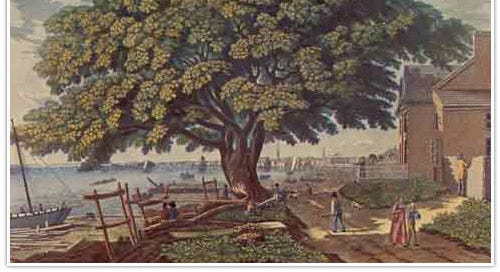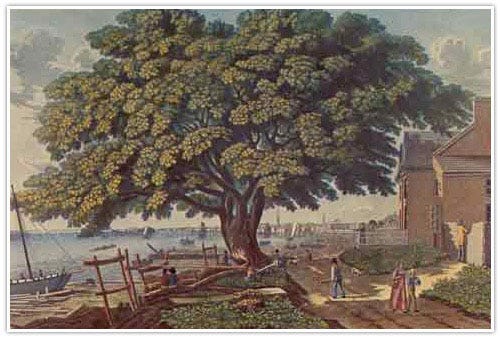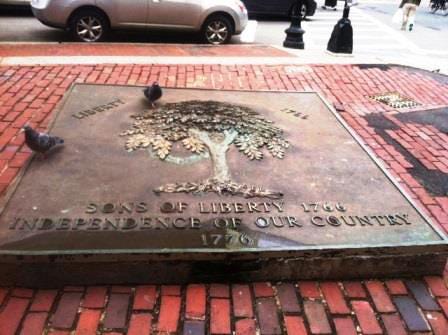The year was 1765 when the British Parliament passed the Stamp Act, which imposed a tax on every document issued in the American colonies. Everything printed on paper, from contracts and court records to newspapers and pamphlets, had to be stamped proving that it had paid a tax to the British Crown. The act was received in the colonies as an affront to their rights as Englishmen and became one of the earliest dominoes that led to revolution within a decade.
Spontaneous protests registered the colonist’s hatred of the act, and no more so than in Boston … the cauldron of the revolution … including one that took place under a tree. The tree was, as a patriot at the time described it, “a stately elm… whose lofty branches seem’d to touch the skies.” It was planted in 1646 along the only road out of town, making it visible to anyone entering or leaving Boston by land. On August 14, 1765, the 119-year-old landmark became ground zero for Boston’s anger.
Boston’s “Loyal Nine” was a clandestine group of 9 merchants and artists opposed to British actions in the colonies and was the seed that became the Sons of Liberty. They took action in protest of the Stamp Act and overnight had secretly “decorated” the famous elm so that Boston awakened to see two objects hanging from the tree. One was an effigy bearing the initials “AO,” a reference to Andrew Oliver, the man charged with collecting Stamp Act taxes for the British. The effigy held a sign that read “What Greater Joy did ever New England see than a Stampman hanging on a Tree!” Next to the effigy hung a boot with a devil-figure holding a copy of the act, an apparent reference to Lord Bute, the prime minister the colonists blamed for the act’s passage.
Bostonians began to gather by the tree, eventually numbering in the hundreds. When the Sherriff arrived to clear the tree of the effigies, he was prevented from doing so by the crowd. The crowd became celebratory as they put the effigy in a coffin, which they then paraded through the streets of Boston shouting, “Liberty, property, and no stamps!” Then things began to escalate. A building that belonged to Andrew Oliver (the Stampman effigy) was destroyed while the crowd gathered at his home. Oliver was not there as he had wisely fled, and the crowd beheaded and burned the effigy as they ransacked Oliver’s house and drank his liquor. The next day Oliver resigned his position as Stamp Commissioner. A few weeks later a copper sign reading “Tree of Liberty” was placed on the elm by the Loyal Nine.
The tree became a rally site for protest, and it soon had many flyers protesting the Stamp Act adorning its trunk. The symbolism of a “Liberty Tree” began to spread beyond Boston, and before long many communities established their own Liberty Trees, even as far away as South Carolina. The following year when the Stamp Act was repealed, in part because of “liberty Tree protests” throughout the colonies, Bostonians gathered once again beneath the elm to decorate it with flags and lanterns and brightly colored streamers. For the next decade the Liberty Tree was the primary site for Boston’s increasing revolutionary protests.
After the battles of Lexington/Concord in 1775, Thomas Paine bolstered the American spirit with a poem about the Liberty Tree and what it meant to American patriots. Four months after the battles, loyalists and British Troops cut the elm down into 14 cords of firewood in revenge for the revolutionary spirit it had engendered.
When the British were forced to evacuate Boston, patriots attempted to reclaim the site by affixing a “Liberty Pole” to the stump of the tree, but the site never really regained its former popularity. Today the site is marked with a plaque embedded in a small brick plaza.
Unlike other symbols of the revolution … the Liberty Bell, Old North Church, Independence Hall … the Liberty Tree seemed to fade in American history, despite receiving praise into the 19th Century. When Lafayette visited Boston in 1825, he proclaimed, “The world should never forget the spot where once stood Liberty Tree, so famous in your annals.” And in a 1787 letter Jefferson secured its place in history with the oft repeated quote, “The tree of liberty must be refreshed from time to time with the blood of patriots & tyrants.”
Why has America all but forgotten its Liberty Tree? I can think of two reasons, though it’s just a guess on my part. The first is that the British cut the damn thing down and burned it as firewood. But in the rebellious colonies the Liberty Tree became a concept, and the Liberty Tree was any tree the patriots called a Liberty Tree. So, I think a greater reason is that the Liberty Tree never really represented liberty … it represented the upheaval that results from oppression, and the ugliness with which sometimes liberty must be defended. That, and its association with lynching … a practice which would later create a very shameful chapter in American history ... is likely why, among the family of American symbols, the Liberty Tree is that relative that no one talks about much.
NEXT WEEK: Black Hand on the Sun






Great article. Learned something today.